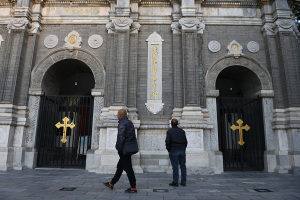Southern Japan 6.4-Magnitude Earthquake Kills Nine, Injures Hundreds; More Feared Trapped Under Collapsed Structures
In Kyushu's Mashiki town, near the city of Kumamoto, thousands of people were displaced as they fled their homes and spent the night out in the open after a powerful earthquake shook the southern portion of Japan. The initial count of two people who died from the aftermath has since risen to nine while the number of injured is in excess of 250. Still more casualties are feared buried under the rubble, and relief operations were hampered by strong aftershock tremors. Buildings had toppled over, and near the epicenter, electricity, water, and gas supplies were cut off.
The 6.4-magnitude quake recorded by the Japanese Meteorological Agency centered on areas east of Mashiki on Thursday 9:26 p.m. No tsunami warnings were issued, and nuclear reactors on the island were reported to be functioning normally. But the magnitude had been downgraded to 6.2 based on the record of the United States Geological Survey.
The government's chief spokesman, Yoshihide Suga, has said he would visit the area Friday in order to assess the damage sustained. He also pointed out that many of those who had been hurt were severely injured. Nineteen houses had collapsed while calls have come in at the hundreds, reporting property damage and people being trapped inside buildings or under collapsed structures.
Mashiki, population 34,000, was the worst-hit town and was where the shaking had been reported as most intense. It is 1,300 kilometers southwest of Tokyo and 15 kilometers east of Kumamoto. Two of those who had been killed were from this town. One had been pulled from the rubble while the other had died in a fire.
A night-duty official of the Kumamoto Prefectural Police, Hironobu Kosaki, shared his experience to Fox News, "The shaking was so violent I couldn't stand still."
During a news conference, Gen Nakatani, Japan's Defense Secretary, said that planes and helicopters were sent to affected areas to assist in rescue operations while defense troops have also been deployed.
There is a high risk of more buildings collapsing as "This is an earthquake that is going to shake for a long time," according to CNN meteorologist Chad Myers. "The buildings that were damaged in the original shock have now been redamaged or reshaken. And all of a sudden you have a cracked building, and it wants to fall down with the second shake."
John Bellini of the U.S. Geological Survey also explained that the shallow depth of the quake at 10 kilometers implies a greater possibility for more damage to occur, since the shaking is very close to the surface.
The region is bracing itself for unpredictable aftershocks in the next few days.




























